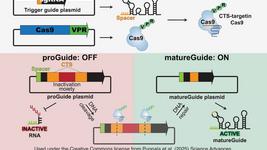CMN Weekly (4 April 2025) - Your Weekly CRISPR Medicine News
By: Gorm Palmgren - Apr. 4, 2025
Top picks
- A blue-light-activated CRISPR-Cas13 RNA base editor, PA-rABE, enables precise, reversible control of gene expression by splitting ADAR2 deaminase using the Magnets system. It efficiently edits endogenous RNA with minimal off-target effects. In mice, PA-rABE stabilised β-catenin by editing CTNNB1 and restored clotting in a haemophilia B model, highlighting its potential for spatially and temporally controlled therapeutic RNA editing.
- A new gRNA design strategy significantly enhances ADAR-mediated RNA base editing by mimicking structural features of highly edited inverted Alu repeats. Named MIRROR (mimicking inverted repeats to recruit ADARs using engineered oligoribonucleotides), the approach improves editing efficiency by up to 5.7-fold in various human cells and disease models, offering a rational design framework for safer, nonpermanent RNA editing therapies.
Research
- High-throughput profiling of 24 Cas12a variants revealed distinct PAM compatibilities and editing efficiencies. Deep learning models were developed to predict variant-specific activity. The authors also improved GUIDE-seq by correcting tag truncation and thereby creating enGUIDE-seq for more accurate off-target and translocation detection. This approach enables the rational selection of Cas12a variants for precise genome editing.
- American researchers demonstrate a CRISPR-Cas9 strategy for engineering haematopoietic stem and progenitor cells (HSPCs) to deliver both intrinsic and extrinsic resistance to HIV-1. The approach combines CCR5 gene knockout with long-term antibody secretion from B cell progeny, enabling a one-time autologous transplant therapy targeting both R5- and X4-tropic HIV strains. Matthew Porteus from Stanford University led the research, and you can hear him talk about it Tuesday morning at the 2nd CRISPR Medicine Conference in Copenhagen.
- Using high-field NMR, American researchers show that REC3 in SpCas9 functions as an allosteric switch, toggling between "pre-active" and "surveillance" states. Millisecond-timescale motions in REC3 and HNH subdomains modulate cleavage specificity, particularly at PAM-distal mismatches. This dynamic interface provides a mechanistic basis for engineering Cas9 variants with improved precision.
- An ADAR1-regulated A-to-I RNA editing event in CYP1A1 (I462V) promotes NSCLC progression by activating PI3K/Akt signalling and inducing nuclear HO-1 translocation, enhancing oxidative stress resistance. This edited isoform confers gain-of-function effects absent in wild-type CYP1A1. The CYP1A1–HO-1–PI3K/Akt axis represents a potential therapeutic target in lung cancer driven by aberrant RNA editing.
- TOPO-seq, a new off-target detection method, maps genome-wide Cas9 and base editor activity while accounting for DNA topology. It revealed that over 50% of off-targets occur at highly mismatched sites overlooked by conventional approaches. In therapeutic gRNA tests, six of 47 off-targets were topology-induced. TOPO-seq enhances safety profiling by exposing hidden off-target risks relevant to clinical genome editing.
Industry
- AIRNA has raised $155 million in Series B funding to advance AIR-001, an RNA-editing therapy for alpha-1 antitrypsin deficiency. The candidate repairs the PiZ mutation in SERPINA1 to restore functional protein expression. A clinical trial application is expected in late 2025. Proceeds will also support the development of additional RNA-editing therapies targeting cardiometabolic and other diseases.
- Sangamo Therapeutics has licensed its STAC-BBB AAV capsid to Eli Lilly for CNS gene therapy delivery. STAC-BBB enables intravenous delivery across the blood-brain barrier, with proven neuronal transduction in primates. Lilly gains exclusive rights for one target, with options for four more. The deal includes $18 million upfront and up to $1.4 billion in milestones and royalties.
- CRISPR Therapeutics' chief operating officer, Julianne Bruno, has departed, becoming the seventh senior executive to exit since 2023, following the FDA approval of its CRISPR-Cas-based sickle cell therapy, Casgevy. Meanwhile, leadership shake-ups also hit Aurion Biotech, Nkarta, Arbutus Biopharma, and others, reflecting broader executive turnover across the biotech sector last week.
- The contract research organisation IRBM has launched an expanded CRISPR-based Functional Genomics Platform to de-risk target validation in drug discovery. The platform combines genome-wide CRISPR screens, tiling, and base/prime editing with disease-relevant cell models and multi-omics profiling. By mapping gene function and regulatory elements, IRBM enables more reliable identification of actionable targets, enhancing early-stage decision-making for biopharma partners across oncology, neurodegeneration, and rare diseases.
Clinical
- Epicrispr Biotechnologies has received FDA clearance to begin clinical trials of EPI-321, a CRISPR-Cas-based epigenetic therapy targeting DUX4 in facioscapulohumeral muscular dystrophy. Delivered via AAV, EPI-321 silences aberrant gene expression and has shown strong preclinical efficacy. A global Phase 1/2 trial will launch in 2025, following earlier approval in New Zealand.
- Intellia Therapeutics has dosed the first patient in MAGNITUDE-2, a pivotal Phase 3 trial of its in vivo CRISPR-Cas therapy nexiguran ziclumeran for hereditary ATTR amyloidosis with polyneuropathy. The single-dose treatment inactivates the TTR gene, aiming to halt or reverse disease progression. Phase 1 data of nexiguran ziclumeran showed deep, durable TTR suppression.
- YolTech Therapeutics has dosed the first patient in an investigator-initiated trial of YOLT-101, an in vivo CRISPR-Cas base editing therapy targeting PCSK9 for familial hypercholesterolemia. Delivered via lipid nanoparticles, a single dose of YOLT-101 aims to lower LDL cholesterol permanently. Preclinical data showed a near two-year LDL-C reduction in primates, supporting the potential for long-lasting clinical benefit.
Delivery
- A genome-wide CRISPR-Cas9 screen identified TRIM25 as a proton-activated suppressor of exogenous LNP-mRNA, promoting decay via endoribonucleases. m1Ψ modification reduces TRIM25 activity, enhancing RNA stability. HSPGs and V-ATPase were also key to uptake and escape. These findings are directly relevant to improving the delivery and efficacy of CRISPR-based therapeutics.
- A Gag-only LVLP system was developed to safely deliver PAMless base editor CE-8e-SpRY mRNA and sgRNAs, avoiding integration risks linked to Pol. Incorporating psi and HDV ribozyme elements enabled up to 50% editing efficiency in 293T cells and 20% in Jurkat cells. This platform offers a safer, more efficient method for base editing, relevant to cancer immunotherapy targeting PD1 and related genes.
- A non-viral lipofection method enabled efficient CRISPR-Cas9 editing of TRPV1, NTSR2, and CACNA1E in primary human DRG neurons, confirmed across genomic, protein, and functional levels. This approach avoids neurotoxic viral vectors, offering a safer platform for gene editing in sensory neurons and supporting future clinical development for neurological and pain-related disorders.
Screening
- CRISPR-Cas9 screens in HER2-positive breast cancer cells identified TSC1 and TSC2 loss as novel resistance mechanisms to T-DM1 and related HER2 therapies. Knockout increased T-DM1 internalisation but reduced drug efficacy. Combined treatment with T-DM1 and mTOR inhibitor everolimus showed synergistic effects, suggesting a potential strategy to overcome resistance and improve therapeutic outcomes.
- Using a modified promoter-reporter system and CRISPR activation screening in ovarian cancer cells, four novel MYC promoter activators – ABI1, PCED1A, HOOK2, and CYP4v2 – were identified. Each enhanced MYC promoter activity over twofold upon overexpression. These findings highlight potential therapeutic targets for overcoming chemoresistance driven by MYC in ovarian cancer.
- A genome-wide CRISPR-Cas screen identified BUB1 as a selective dependency in malignant pleural mesothelioma cells. BUB1 depletion impaired mitotic checkpoint function, triggered G2/M arrest, apoptosis, and senescence, and disrupted key mitotic regulators. Its inhibition curtailed tumour cell survival, with high BUB1 expression correlating with poor prognosis, highlighting BUB1 as a potential therapeutic target in this aggressive cancer.
Detection
- A CRISPR-Cas14a platform was developed to detect rifampicin and isoniazid resistance in Mycobacterium tuberculosis. It achieved ≥93% sensitivity and 100% specificity in clinical isolates and performed reliably on sputum samples, identifying resistance within 1.5 hours. This rapid, accurate assay offers a promising tool for timely detection of multidrug-resistant tuberculosis.
- A CRISPR-Cas12a-based diagnostic targeting the transmissible gastroenteritis (TGE) N gene was developed using fluorescence and lateral-flow readouts. Both assays showed high specificity with no cross-reactivity and sensitivities of 100 and 102 copies/µL, respectively. Coupled with LAMP amplification, this system offers a rapid, portable, and accurate method for TGEV detection, improving diagnostic efficiency for outbreak control.
- Researchers have developed a one-step CRISPR-Cas12a assay using enzymatic recombinase amplification (ERA) to rapidly detect Candida albicans. A paraffin-based system enables temperature-controlled merging of amplification and detection steps within a sealed tube, preventing contamination. The method detects as little as 100 ag/µL DNA in 30 minutes with high specificity, offering a fast, contamination-resistant diagnostic tool for invasive candidiasis.
- The R-CHIP platform combines RPA, CRISPR-Cas detection, manual microfluidics, and AI to enable multiplexed detection of high-risk HPV types. It delivers results within an hour, with attomolar sensitivity and over 95% accuracy in clinical tests. Smartphone-based imaging and deep learning automate result interpretation, offering a low-cost, portable solution for cervical cancer screening in resource-limited settings.
Perspectives
- The Motley Fool reports biotech stocks like CRISPR Therapeutics dropped sharply after FDA biologics chief Dr Peter Marks resigned, citing conflict with new HHS Secretary Robert F. Kennedy Jr. Marks' departure raises concerns over delays in gene therapy approvals. Combined with market-wide risk aversion, uncertainty around regulatory timelines has hit early-stage, revenue-light biotech firms particularly hard. Read a related article here.
- An article in Inside Precision Medicine highlights the growing use of CRISPR-Cas and related technologies in autoimmune disease, including CTX112 from CRISPR Therapeutics, now in Phase I for lupus. Other strategies – mRNA CAR T cells (Cartesian), gene-edited stem cells (RheumaGen), and T regulatory cell therapy (PolTREG) – aim to restore immune tolerance, marking a shift toward durable, potentially curative treatments beyond cancer and rare diseases.
- In the CRISPR Journal, an interdisciplinary team reflects on challenges faced while researching CRISPR gene editing across biomedical, ethical, and societal domains. Drawing from their own collaborative project, they propose strategies to foster cross-disciplinary dialogue, including setting shared goals, managing expectations, and integrating expert and lay perspectives. Their aim is to support ethically grounded, socially informed research as CRISPR moves further into clinical application.
Reviews
- Reinvigorating AMR resilience: leveraging CRISPR–Cas technology potentials to combat the 2024 WHO bacterial priority pathogens for enhanced global health security – a systematic review. This review evaluates the potential of CRISPR–Cas systems to combat antimicrobial resistance by targeting resistance genes in WHO-priority pathogens, highlighting advances, delivery strategies, and challenges for clinical application.
- Innovative Chemical Strategies for Advanced CRISPR Modulation. This review explores emerging chemical and materials-based strategies for precise, reversible control of CRISPR-Cas activity through guide RNA modulation, bioorthogonal chemistry, and engineered molecular structures.
News from CRISPR Medicine News
- At CRISPR Medicine News, we are all excited about next week's CRISPR Medicine Conference 2025 in Copenhagen – the second international CRISPRMED conference we are organising. More than 400 participants from all over the world will gather to hear keynote speaker Virginijus Šikšnys, patient advocate Jimi Olaghere - one of the first to receive the recently approved CRISPR therapy CASGEVY – more than 60 other speakers, panellists, etc plus 80 poster presentations. We hope to see you all on Monday for the virtual event and Tuesday to Friday for the live event!
To get more CRISPR Medicine News delivered to your inbox, sign up to the free weekly CMN Newsletter here.
Tags
ArticleMissing linksNewsCMN WeeklyRNA editingADAR (adenosine deaminase acting on RNA)AIRNACRISPR Therapeutics AGEpicrispr BiotechnologiesIntellia Therapeutics, Inc.Sangamo Therapeutics Inc.YolTech Therapeutics
CLINICAL TRIALS
IND Enabling
Phase I
Phase II
Phase III
Gastric Cancer and Colorectal Cancer, CRC, (NCT07166263)
Sponsors:
Base Therapeutics (Shanghai) Co., Ltd.
Sponsors:
Base Therapeutics (Shanghai) Co., Ltd.
IND Enabling
Phase I
Phase II
Phase III
Relapsed or Refractory Acute Myeloid Leukemia, AML, (NCT06541444)
Sponsors:
Base Therapeutics (Shanghai) Co., Ltd.
Sponsors:
Base Therapeutics (Shanghai) Co., Ltd.
IND Enabling
Phase I
Phase II
Phase III







